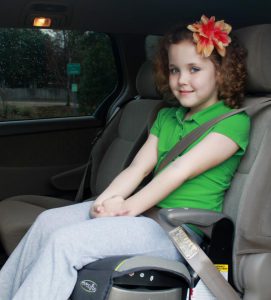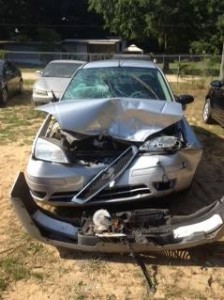
by Ginny Hinton | Feb 10, 2021
If you’re the parent of a “big kid” between the ages of 5 and 12, you’ve probably scratched your head at some point wondering how, where, and in what they should be traveling. There are more options now than ever! Unfortunately, many parents and caregivers make a dangerous choice, without even knowing they could be putting their kids in jeopardy. Following are some of the options for safe travel with older children, including how and why each might work for you:
BELT POSITIONING BOOSTER SEATS
Unlike a car seat, a booster is a positioner, not a child restraint. Its main purpose is to keep the seat belt on the child’s strong hips and collar bone. With a booster, the lap portion of the belt runs under an armrest or clip which holds it low on the hips and upper thighs. This positions the lap belt so that it can’t cut into the child’s soft abdomen, causing serious or potentially life-threatening injuries. Most boosters also position the shoulder belt to keep it flat across the collarbone and protect the neck. An updated study of booster seat effectiveness (Pediatrics, 2009) concluded that children ages 4-8 in boosters are 45% safer from nonfatal injuries than children in seatbelts. The study didn’t find any difference in preventing injury between backless and high-back boosters. Some parents prefer to use high-back boosters because they offer some side-impact protection and give their children a place to lay their heads if they fall asleep. Others prefer the convenience of a lightweight backless booster that can easily travel with the child and be moved between vehicles. A backless booster will NOT work if the vehicle headrest comes below the child’s ears because of the danger of whiplash from rear-end crashes. A child can safely move to a booster seat when he/she has outgrown a car seat by weight and height, as long as the child is mature enough to stay in position while traveling. This usually happens between ages 5-7 but depends on the individual child.

Credit: G. Hinton
VEHICLE LAP-SHOULDER BELTS
How do you know when your child is ready to “graduate” to an adult seatbelt? Because the height and depth of seats vary from vehicle to vehicle, and all children are not made exactly alike, there is no specific height or weight guideline. Instead, there is a simple 5-step test as follows:
• Is your child sitting all the way back in the seat?
• Do the child’s knees reach the edge of the seat without scooting?
• Do the child’s feet touch the floor?
• Does the shoulder belt cross the child’s collar bone and not his/her neck?
• Is the child mature enough to stay in position during the entire trip?
If you can answer “yes” to every question, your child is ready to use an adult seatbelt in that vehicle. If not, no matter what your child’s age, it might be best to continue using a booster seat for a while. When a child is too small sit in an adult seatbelt, the lap belt will slide up onto his/her stomach. In a crash, the belt will keep tightening because there is no bone or other object (i.e. the armrest of a booster) to stop it. During the crash, everything has to stop so fast that it causes the belt to put extreme force on the internal organs and spine, causing the organs to rupture and the spine to snap or fracture. This cluster of injuries is called “seat belt syndrome” and can be severe. Using a booster until your child is big enough to fit the vehicle seat eliminates the risk.
by Ginny Hinton | Jan 30, 2015

There’s a new law in Florida – and although it’s far from comprehensive, it’s designed to better protect our kids. As of January 1, 2015, Florida law requires that all children riding in vehicles must use a safety seat until their 6th birthday. This means that kids who are 4- or 5-years-old and were previously restrained using just a seat belt must now ride in a car seat or booster seat.
Although much of the publicity about the new law also has reinforced the guideline that children under age 13 are much safer in the back seat, the law itself applies only to children who are not yet six. The law is not a “booster seat” law, because children under age 6 are still safer in a 5-point harness. Once your child is at least 4-years-old, weighs at least 40 pounds, and can sit in position for an entire car trip, you may make the decision to move that child to a booster seat. The fact remains, however, that the child is still much safer in a 5-point harness until he/she reaches the upper height or weight limit of that seat (typically 40-65 pounds). Even though your child may beg to differ, keeping him/her in a harnessed seat longer is one of the best gifts you can offer as a parent!
Want to make sure you’re using the best type of restraint for your child? You can find a nationally certified child passenger safety technician near you at http://cert.safekids.org. Click on “Find a Tech” and search by location.
by Ginny Hinton | Jun 5, 2013

The proper seat correctly installed helps keep children safe.
Dawson is a healthy, active 3-year-old whose mom makes sure he eats right, learns something new every day, and rides safely in the car. Until a few months ago, Dawson, who weighs 42 pounds and is 42 inches tall, traveled in a booster seat. When his mom learned that, because of his age, Dawson would be safer in a 5-point harness, she moved him to a safer car seat and made sure it was installed correctly. Just a few weeks ago, Dawson was riding in the car with relatives when someone drove in front of them and caused a 45 mph crash, totaling both cars. One of the adults fractured her collarbone; another suffered a concussion. Dawson bit his tongue and was really scared – but he was unhurt. Dawson’s mom says she is truly thankful she put him in the correct car seat. Because car seats are made to survive only one crash, she has already replaced his old seat and Dawson continues to travel safely in the car.
Dawson’s story can happen to any child. It’s important that every parent know how to keep their children safe on the roads. Here are some quick pointers to keep children safe at every age:
- All infants and toddlers should ride in a Rear-Facing Car Seat until they are 2 years old or until they reach the highest weight/height allowed by the manufacturer. Rear-facing is the safest way to travel!
- Children 2 years to at least 4 years old and 40 pounds should use a Forward-Facing Car Seat with a harness for as long as possible. Keeping a child who weighs more than 40 pounds in a harness is the safest practice, as long as the seat’s weight limits are followed.
- Children whose weight or height is above the forward-facing limit for their car seat should use a Belt-Positioning Booster Seat until the vehicle seat belt fits properly, typically when they are at least 4 feet 9 inches tall and are between 8 and 12 years old. Children using a booster seat should be able to sit reasonably still for an entire trip.
- Children who are old enough and large enough to use the vehicle seat belt alone should always use both Lap and Shoulder Belts for the best protection. Children younger than 13 years should sit in the back seat.
Certified Child Passenger Safety Technicians (CPSTs) are trained to help caregivers make sure their children are traveling safely. Find a CPST near you at http://cert.safekids.org.




